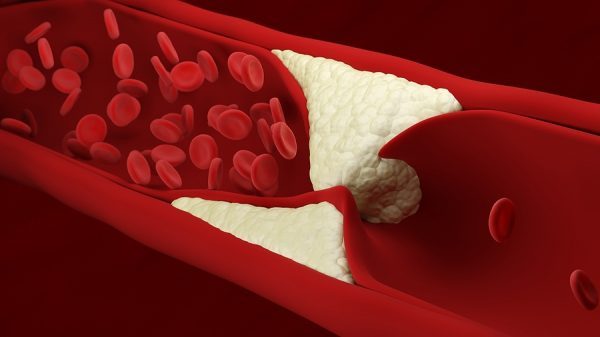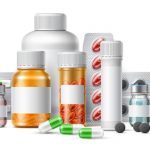By David Blyweiss, M.D., Advanced Natural Wellness
One of the biggest health threats here in the U.S. is the build-up of plaque in the arteries. It’s known as atherosclerosis, and it’s the underlying cause of about 50% of all deaths in westernized countries.
As plaque builds up in the walls of blood vessels, it causes them to narrow and can even block blood flow altogether. A completely blocked artery can lead to a heart attack or stroke.
But most of the damage happens when plaques rupture, which is what causes the majority of acute cardiovascular events. Some reports estimate that as many as 75% of heart attacks are caused by ruptured plaque.
When plaque ruptures, a piece of it can break off. Ruptured plaques are also known to cause the formation of blood clots. Either of these can break away and travel to arteries that lead to the heart or brain and, once again, result in a heart attack or stroke.
So plaque is a really big concern. Big Pharma’s solution is to throw statins at everyone to lower LDL cholesterol. But LDL cholesterol isn’t the problem at all.
In fact, most people aren’t even aware of how important LDL is to their good health.
It’s an antioxidant and a critical part of cell membranes. Your body uses it to produce sex hormones, maintain neurological function, make vitamin D and support and preserve brain function.
It protects you, and is absolutely necessary to your existence!
Cholesterol production is so important to bodily function that your liver makes 80% to 85% of it. Only about 15% to 20% comes from the food you eat.
And here’s something else you might not realize.
Lipoproteins aren’t even cholesterol. Rather, they are protein molecules that carry fats, proteins, antioxidants and cholesterol through your bloodstream and delivers them where they’re needed. So the term “LDL cholesterol” is actually an inaccurate description.
But if it’s not “bad cholesterol” that’s causing all of that plaque buildup in the arteries, what is?
It’s All About LDL Quality
While LDL in and of itself is not dangerous or harmful to you, the quality of the LDL particles can have very big influence on the health of your arteries and the accumulation of artery clogging plaque.
In particular, there is a protein found in lipoprotein particles called Apolipoprotein B (apoB), which is highly atherogenic and promotes plaque buildup in your arterial walls. High apoB is thought to be the initiator of the entire plaque cascade, and is associated with a higher number of small, dangerous LDL particles.
Some LDL particles are large and buoyant, and no threat to your health. It’s the small, dense particles that cause problems. They squeeze through the lining of your blood vessels where they oxidize.
That oxidation is significant when it comes to the formation of plaques. Oxidized LDL (oxLDL) particles that have slipped into the walls of your blood vessels are extremely inflammatory and have shown to not only be a factor in plaque development, but also in plaque destabilization that can lead to ruptures.
And here’s the deception.
Your doc probably checks your “LDL cholesterol” at your regular visits. Big Pharma makes sure they do that so you can walk home with a statin drug in hand if your levels are high.
But they never test you for the real cause of clogged arteries and plaque build-up in your blood vessels – apoB levels, particle size and excessive oxidized LDL.
A Vertical Auto Profile (VAP) test will measure your apoB levels and tell you if your LDL particles are the small dangerous one or the large harmless ones. And an oxLDL test can give you a handle on how damaged your LDL particles are.
Naturally Stabilize and Reduce Your Plaques
Once you have plaque in your blood vessels, you really can’t get rid of it completely. But you can reduce the volume and stabilize it to help prevent future ruptures.
Omega 3 fatty acids like those found in fish are great for your vascular system. In particular, eicosapentaenoic acid (EPA) reduces circulating levels of apoB-containing lipoprotein particles, small dense LDL and oxidized LDL. Additionally, EPA reduces plaque instability and plaque inflammation.
Choose wild-caught fish that are lower on the food chain like Pacific halibut, mackerel, Alaskan salmon, sardines, herring, rainbow trout and flounder. If you don’t like seafood try a high-quality omega-3 fish oil supplement.
Nuts are another great food source to reduce plaque build-up. They contain high amounts of phytosterols that help lower levels of apoB. This could explain why people who eat the most tree nuts have a lower risk of heart attack or stroke.
In particular, nut eaters have much lower rates of coronary heart disease, which is driven by plaque build-up in the arteries.
It doesn’t matter what kind of tree nut you eat, all of them will help lower levels of apoB. So mix them up. And make sure to add in some pistachios and pecans, which both have the added benefit of reducing oxLDL.
Flavonoid and antioxidant-rich fruits and vegetables can also help reverse some of the damage. In as little as two weeks a diet high in these plant-based foods can increase resistance to LDL oxidation up to 28%.
And when people ate a DASH style diet rich in fruits and vegetables – and low in unhealthy fats, sugar and high glycemic foods – some wonderful things happened. The composition and volume of plaque in their arteries changed for the better.
The volume of noncalcified plaque was reduced, and the progression of atherosclerosis slowed down.
This is one more reason to focus on a plant-based diet and avoid foods that are processed, sugary, fried or contain unhealthy fats.
And by the way, a high salt intake is associated with nearly three times the risk of developing unstable plaques. So there’s no time like the present to start doing your best to lower your sodium intake.
SOURCES:
Pahwa R, Jialal I. Atherosclerosis. In: StatPearls [Internet]. Treasure Island (FL): StatPearls Publishing. Updated Aug 2022.
Gonçalves I, Andersson Georgiadou E, Mattsson S, Skog G, Pedro L, Fernandes E Fernandes J, Dias N, Engström G, Nilsson J, Stenström K. Direct association between diet and the stability of human atherosclerotic plaque. Sci Rep. 2015 Oct 22;5:15524.
Morris P, McLain K, Malave H, Underberg J, Le N, Shapiro M, Winegar D, Pourfarzib R. Relationship between plasma apolipoprotein B concentrations and LDL particle number. Research Reports in Clinical Cardiology. 2014;5:237-242.
Sniderman AD, Thanassoulis G, Glavinovic T, Navar AM, Pencina M, Catapano A, Ference BA. Apolipoprotein B Particles and Cardiovascular Disease: A Narrative Review. JAMA Cardiol. 2019 Dec 1;4(12):1287-1295.
Sacks FM, Campos H. Low-Density Lipoprotein Size and Cardiovascular Disease: A Reappraisal. J. Clin. Endocrinol. Metab. 2003;88(10):4525–4532.
Maiolino G, Rossitto G, Caielli P, Bisogni V, Rossi GP, Calò LA. The role of oxidized low-density lipoproteins in atherosclerosis: the myths and the facts. Mediators Inflamm. 2013;2013:714653.
Mason RP, Sherratt SC, Jacob RF. Eicosapentaenoic Acid Inhibits Oxidation of ApoB-containing Lipoprotein Particles of Different Size In Vitro When Administered Alone or in Combination With Atorvastatin Active Metabolite Compared With Other Triglyceride-lowering Agents. J Cardiovasc Pharmacol. 2016 Jul; 68(1): 33–40.
Garrido-Sánchez L, García-Fuentes E, Rojo-Martínez G, Cardona F, Soriguer F, Tinahones FJ. Inverse relation between levels of anti-oxidized-LDL antibodies and eicosapentanoic acid (EPA). Br J Nutr. 2008 Sep;100(3):585-9.
DiNicolantonio JJ, O’Keefe JH. The Benefits of Omega-3 Fats for Stabilizing and Remodeling Atherosclerosis. Mo Med. 2020 Jan-Feb;117(1):65-69.
Del Gobbo LC, Falk MC, Feldman R, Lewis K, Mozaffarian D. Effects of tree nuts on blood lipids, apolipoproteins, and blood pressure: systematic review, meta-analysis, and dose-response of 61 controlled intervention trials. Am J Clin Nutr. 2015 Dec;102(6):1347-56.
Larsson SC, Drca N, Björck M, Bäck M, Wolk A. Nut consumption and incidence of seven cardiovascular diseases. Heart. 2018 Oct;104(19):1615-1620.
Kay CD, Gebauer SK, West SG, Kris-Etherton PM. Pistachios increase serum antioxidants and lower serum oxidized-LDL in hypercholesterolemic adults. J Nutr. 2010 Jun;140(6):1093-8.
Hudthagosol C, Haddad EH, McCarthy K, Wang P, Oda K, Sabaté J. Pecans acutely increase plasma postprandial antioxidant capacity and catechins and decrease LDL oxidation in humans. J Nutr. 2011 Jan;141(1):56-62.
Hininger I, Chopra M, Thurnham DI, Laporte F, Richard MJ, Favier A, Roussel AM. Effect of increased fruit and vegetable intake on the susceptibility of lipoprotein to oxidation in smokers. Eur J Clin Nutr. 1997 Sep;51(9):601-6.
Kiokias S, Proestos C, Oreopoulou V. Effect of Natural Food Antioxidants against LDL and DNA Oxidative Changes. Antioxidants (Basel). 2018;7(10):133.
Henzel J, Kępka C, Kruk M, Makarewicz-Wujec M, Wardziak Ł, Trochimiuk P, Dzielińska Z, Demkow M. High-Risk Coronary Plaque Regression After Intensive Lifestyle Intervention in Nonobstructive Coronary Disease: A Randomized Study. JACC Cardiovasc Imaging. 2021 Jun;14(6):1192-1202.
Li L, Zhao Z, Wang Y, Gao X, Liu G, Yu B, Lin P. Association Between Dietary Intakes and Plaque Vulnerability Measured by Optical Coherence Tomography in Patients With Coronary Heart Disease: A Mediation Analysis of Inflammatory Factors. Front Nutr. 2022 Jun 14;9:920892.




